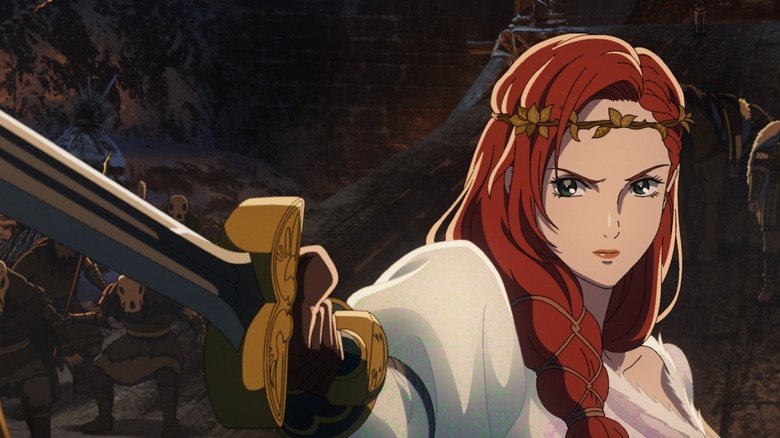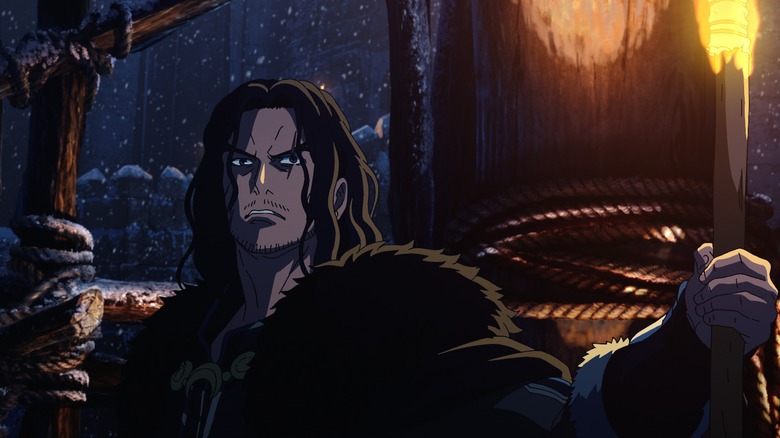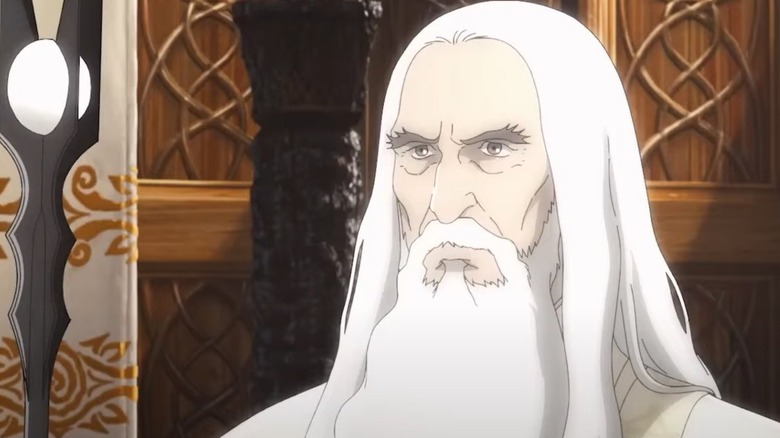
Spoilers are never late, nor are they early, but arrive precisely when they mean to. That time is now, as this article discusses major plot details from “The Lord of the Rings: The War of the Rohirrim.”
Who knew that everything old would officially become new again in Middle-earth? Although the main appeal of “The War of the Rohirrim” has always been the idea of getting to know a whole new cast of characters to root for and against, we’ve known that a familiar face or two from the “Lord of the Rings” trilogy would be coming along for the ride in this particular story. Embroiled in a struggle to prevent bloodshed among the people of the horse-centric country of Rohan, the princess Hèra (voiced by Gaia Wise) emerges as a hero unlike any we’ve seen in this franchise before. Luke Pascqualino’s Wulf accomplishes much the same from the other side of the aisle, in terms of the villains. Director Kenji Kamiyama, producer Philippa Boyens, and the entire “War of the Rohirrim” creative team have been trumpeting these new additions for months … but, at the same time, one of the biggest surprises of the film comes courtesy of an established character fans know and love to hate.
Those who’ve read up on their J.R.R. Tolkien lore likely remember that the setting of this new story was always an interesting one, taking place almost 200 years before the events of the original “The Lord of the Rings” trilogy. Although this predates notable names like Frodo, Sam, and the rest of the hobbits, that actually made it possible for a few other major cameos and name-drops. One in particular takes place right at the end, when the wizard Saruman the White (voiced by Christopher Lee) comes out of nowhere to make an ominous appearance among the Rohirrim at their moment of triumph. Though it might seem abrupt, the seeds had been laid all throughout the plot to deliver a sneaky, villainous origin story hiding in plain sight.
An uneasy alliance and a Lord of the Rings location we’ve seen before
One needn’t be a Tolkien scholar to have picked up on the first of the film’s many hints that a Saruman cameo was in the works in “The Lord of the Rings: The War of the Rohirrim.” Okay, so we actually knew this was happening when those involved directly confirmed that the late, great Christopher Lee would reprise his role as the evil wizard one last time. But as far as in-universe clues go, fans should’ve perked up their ears from the moment that the Dunlendings first sauntered onto the scene early on and, subsequently, when the Wild Men of the Hill Tribes began to play such a big role. In Middle-earth history, Dunland (which literally translates to “Dark Land,” because subtlety is for cowards) has always been a thorn in the side of Rohan. This ancient rivalry finally spills over into open bloodshed in “The War of the Rohirrim,” though this would only be a prelude to a corrupted Saruman eventually going even further and stirring up their animosity against Rohan during the events of “The Two Towers.”
But in order to reach that point, a powerful wizard teaming up with the ring-hungry Dark Lord Sauron first needs a place to call his own. Enter the strategically-important region known as Isengard and its unmistakable tower fortress called Orthanc. When Wulf is banished from Rohan as a result of his father’s reckless gambit for the throne, he wastes no time gathering the neighboring Hill Tribes to the cause and occupying Isengard as his base of operations. In a bit of a surprise reveal, Hèra’s kidnapping leads to her imprisonment here and her friends needing to stage a brazen prison break right out from under Wulf’s nose.
The canon dictates that Saruman will one day move into this locale and, wouldn’t you know it, we find out exactly how he does so.
The War of the Rohirrim explains how Saruman took over Isengard
With everything else this war drama has in mind, it’s kind of remarkable that “The War of the Rohirrim” finds the time to throw fans one last bone in the form of Saruman’s “origins,” so to speak. Although ancient beyond years and already a formidable power by the events of this film, Saruman had yet to set up residence in Isengard just yet. In Tolkien’s writings (in actuality, “War of the Rohirrim” adapts mere paragraphs of information included in the appendices at the end of the “Return of the King” novel), we find out that Saruman arrives unexpectedly in Rohan just when they’ve defeated Wulf and installed Fréaláf (Laurence Ubong Williams) as their new king. The long version is that the Men of Gondor handed Saruman the keys to Orthanc in the hopes that he would serve a vital role, protecting a key strategic landmark called the Gap of Rohan that affected possible invasion routes for both Rohan and Gondor. In keeping with this, the movie recreates this faithfully and simplifies things a bit, removing Gondor from the picture entirely and having him announce his willingness to offer “assistance” as Master of Isengard, as needed.
Of course, it’s clear from the “Lord of the Rings” movies that this will lead to nothing but trouble. In fact, there’s another moment that directly hints at this, as well: when two orcs (voiced by fan-favorite franchise actors Dominic Monaghan and Billy Boyd) are caught by Hèra stealing rings off corpses under orders from Mordor. Considering Saruman’s eventual fall from grace as he join forces with Sauron — in the books, this is depicted as more of a rivalry as he seeks to claim the One Ring for himself rather than submit to Sauron — this might as well be a flashing neon sign with the word “FORESHADOWING.” Taken together, all of this acts as a nifty explainer unfolding in the background for one of the biggest villains from the original trilogy.
“The Lord of the Rings: The War of the Rohirrim” is now playing in theaters.




Leave a Reply